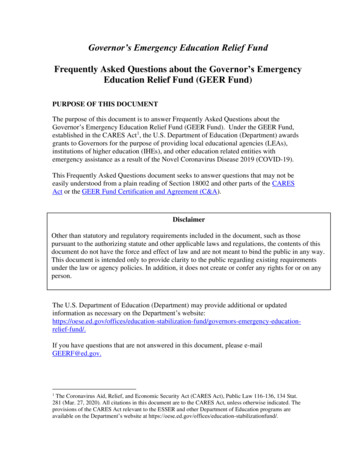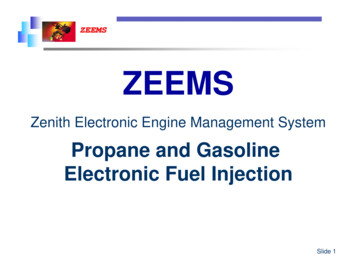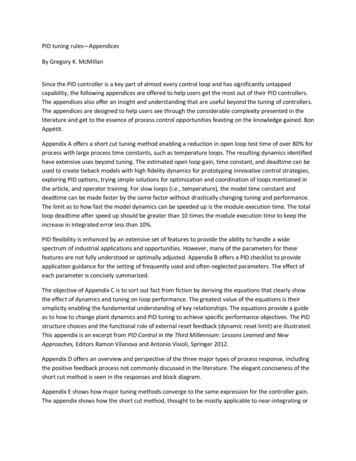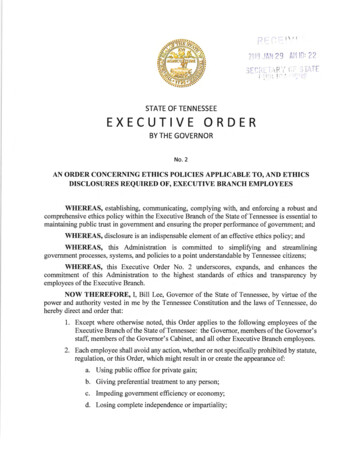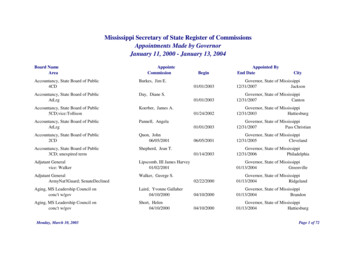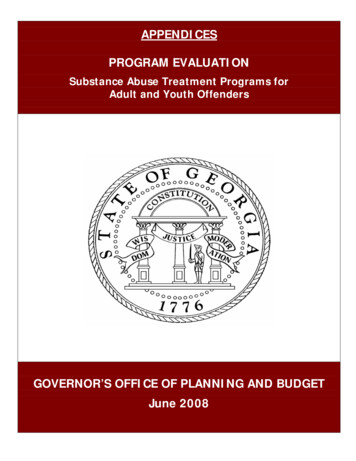
Transcription
APPENDICESPROGRAM EVALUATIONSubstance Abuse Treatment Programs forAdult and Youth OffendersGOVERNOR’S OFFICE OF PLANNING AND BUDGETJune 2008
APPENDIX ASubstance Abuse Treatment Programming in GeorgiaSubstance Abuse Treatment and Intervention Programs for Offenders in GeorgiaThis section focuses on the different types of substance abuse services available tooffenders in Georgia. The following sections offer specific details on the types ofsubstance abuse treatment programming available to offenders in Georgia. Theseprograms often reflect many of the recognized best practices identified across thenation. Each program is categorized by the department offering that particulartreatment. A brief section describing these departments offers more insight into themanner in which these offender populations are generally managed.Department of CorrectionsThe Department of Corrections (DOC) administers the prison and probation sentencesof offenders adjudicated by Georgia courts. At any given time, more than 52,000 ofthese offenders are serving prison sentences, and another 140,000 offenders are onprobation. The Corrections Division is responsible for the direct supervision of alloffenders sentenced to the Georgia Department of Corrections. The Division operatesand maintains a variety of physical infrastructure: 37 state prisons, housing nearly 37,000 inmates 3 private prisons 24 county prisons 9 transitional centers 6 inmate boot camps 1 probation boot camp 19 probation detention centers 13 diversion centers 5 day reporting centers 120 probation officesAuthority: Titles 9, 42, and 77 of the Official Code of Georgia Annotated-2-
Residential Substance Abuse Treatment (RSAT)Program DescriptionRSAT is a six and nine-month program targeting high-risk, high-need offenders with ahistory of substance abuse as a causative factor leading to correctional supervision.The goal of the RSAT program is to return to society a graduate who is law abiding,self-supporting, and pro-social citizen, and thereby reducing recidivism.The foundation of this program is rooted in research studies by renowned researchersin the fields of substance abuse and corrections such as Edward J. Latessa, JamesBonta, Paul Gendreau, D.A. Andrews, and others. The program also incorporates the13 National Institute of Drug Abuse (NIDA) principles that support effective substanceabuse treatment: Effective treatment is multifaceted, addresses multiple needs, and is notdirected solely at alcohol or drug abuse issues.Treatment should be based on an individualized assessment and plan ofintervention. The assessment instrument and treatment plan should addressa wide area of needs, and be ongoing and modified over time.Remaining in treatment for an adequate period of time is critical for treatmenteffectiveness.Counseling (individual and/or group) and other behavioral therapies arecritical components of effective treatment for addiction.Treatment does not need to be voluntary to be effective. Strong motivationcan facilitate the treatment process. Sanctions and reinforcement within thecriminal justice system can increase treatment entry, retention, rates, andsuccess of treatment intervention.Possible drug use during treatment must be monitored continuously.The RSAT and Boot Camp Programs are an intensive, highly structured residentialtherapeutic treatment community where offenders are housed separately from the restof the offender population. The Therapeutic Community (TC) is composed of peergroups and counselor staff that constitute the community in a residential facility.The operation of the community itself is the task of the offenders working together underthe authority and supervision of staff. RSAT incorporates process groups, psychoeducational groups, individual counseling, limited work details, a vocational component,exercise, store, visitation and religious services into the program. The participant’sschedule is a demanding one that balances work with intensive individual and groupcounseling sessions.Program ElementsThe program is structured in four cohesive phases of varying time frames composed ofa “Phase I” Assessment and Orientation. Phase I is the participant’s first experience in-3-
the RSAT program, and this phase will serve to orient the participant to the program, thetherapeutic community, and to treatment in general. Phase I utilizes valid assessmenttools at both pre- and post-treatment (Texas Christian Union Drug Screening: BriefIntake). “Phase II” is an active treatment phase, that focuses on identifying,questioning, and replacing distorted criminal thinking patterns with realistic alternativesto criminal behavior and maladaptive coping strategies. The third phase, re-entry (preexit planning) affords more opportunity for actively practicing the skills and responseslearned during active treatment. The focus of group sessions shifts from the acquisitionof new behaviors and thinking to the application and practice of the concepts and skillsalready acquired. The final phase is relapse prevention – exit planning with the focusshifting to the integration of all that has been learned, practiced and refined. Thisintegration occurs through the development of an in-depth, specific relapse preventionplan.Throughout the six or nine-month programs, offenders participate in random drugscreening. Progression through each phase is based on performance measures andmeeting individualized goals.The RSAT program operates within a Therapeutic Community (TC) where offendershave been segregated from the general population. The TC works as an adjunct to thetreatment curricula by providing a structured community setting. The daily programmingincludes participant education, skills training, family dynamics, and relapse prevention.Program SitesName of InstitutionLocationNumber of Clients ServedDemographics /Cost Per Client198 Clients*Lee ArrendaleFemale Probationers/ Average Cost 3,707.60384 ClientsBainbridgeMale Probationers/Average Cost 3,707.60200 ClientsHomervilleMale Parolees/AverageCost 3,707.60192 Clients*Johnson SPMale Inmates/ Average Cost 3,707.6096 ClientsPulaskiFemale Inmates/ Average Cost 3,707.60240 ClientsScott SPMale Inmates/Average Cost 3,707.60200 ClientsBoot Camp PlusMale Inmates 3,707.60* Price difference due to demographics of programming-4-Funding 734,517.20State Funding 1,423,714,70State Funding & Central ProjectFunds 720,744.30Central Project Funds 715,357.30State Funding 441,024.10State Funding 842,358,02State Funding 720,744.30
Referral ProcessInmates are referred from the Georgia Department Pardons and Parole. Nearly 90percent of inmates who enter the RSAT and/or Boot Camp Plus programs are referredfrom parole.Probationers assigned to Lee Arrendale, Bainbridge and non-parole referrals (inmates)must have a history of substance abuse or dependence. At diagnostics, a substanceabuse history is recorded including the types of substances abused, the frequency andamount of substances used, legal implications, and a note of whether the inmate hasever been in treatment. The COMPAS/TCUDS are the assessment instruments utilizedfor identifying the offenders.Inmates must be parole eligible and within one year of tentative release, whileprobationers are sentenced to complete the program. Program participants cannothave any sexual offenses, violent crimes, or disciplinary reports of the type that mayplace staff in jeopardy for injury.Once an inmate has been identified and screened based on their needs, they areentered into the Offender Tracking Informational System (OTIS). Classification willfurther screen them to ensure they are parole-mandated, and meet the criteria forplacement.Once the inmate arrives at the RSAT site, he or she receives a full assessment fromSpectrum staff to determine the risk for re-offending via the completion of a TexasChristian University Drug Screen Brief Intake, and a more in-depth substance abuseevaluation via an Addiction Severity assessment (ASI). If the inmate is determined tobe a substance abuser or substance-dependent, he signs an agreement to participate inthe program, and is assigned a primary counselor.Program AdministrationThe program is staffed with counselors hired by Spectrum Health Systems, Inc., whomust be either certified addiction counselors or in the process of being certified. Eachcounselor works closely with GDC counselors on case management. An individualtreatment plan is developed for each participant with goals and objectives for eachphase of the program. A recovery plan is developed for aftercare, and is implementedupon release from prison. The program is assignment rich, and the inmates participatein role-plays, sole plays, public speaking, leading both morning meetings and 12-stepmeetings, and other leadership development assignments. Middle Georgia TechnicalCollege teaches the RSAT vocational portion.Both security and non-security staff receive training, ranging from the warden to frontline staff. Everyone in the prison needs to be aware of the purpose of RSAT in order tosupport program effectiveness. RSAT participants are held to a very high standard.Anyone who routinely has contact with an RSAT student is asked to participate in a-5-
multi-disciplinary team meeting to discuss each participant’s behavior. The inmate isexpected to apply the information learned in each class to his behavior. RSAT inmatesunderstand what is expected of them, and are held accountable for their behavior andattitude, whether good or bad.Program Eligibility, Participation, and Graduation ProcessLiteracy is not a requirement of the program, but a cognitive ability to learn is. If aperson does not meet an acceptable level of cognitive ability, he is released from theprogram without penalty. If a person who has the ability to participate in the program,but refuses by either active resistance or passive resistance, then a series ofprogressive disciplinary sanctions are imposed to modify the negative behavior. Thesesanctions include verbal warnings, written assignments, work details, phase setbacks,and finally, termination. Once a participant is terminated from the program, the paroleboard is notified, and in most cases, the inmate will not be released from prison at thepreviously scheduled TPM date.Alternately, upon completion of RSAT, the graduate receives a diploma and it isanticipated that he will parole during his PIC or TPM month. Once the graduate isparoled, the parole plan, completed in the final phase of RSAT, is forwarded to theparole officer. Those offenders who successfully complete the certified RSATvocational program receive 15 technical college credits in the area of Business OfficeTechnology and Customer Service. This program incorporates cognitive behavioralteaching in all aspects of the vocational program.Motivation for ChangeThe Motivation for Change program provides offenders with curriculum designed toenhance an offender’s desire to change his behavior, specifically as it relates tosubstance abuse. This 10-hour program is provided to all incarcerated offenders, asmandated by O.C.G.A. §42-5-20. This program is offered at all sites statewide at nocost to DOC. To date, the completion success rate to date is 9,377 inmates andprobationers statewide.Boot Camp PlusBoot Camp Plus is 160 bed, six-month residential substance abuse treatment programlocated at Scott State Prison. This program targets individuals with drug offenses(excluding dealers), under the age of 40, with no more than one prior felony conviction,and between 25 months and five years to serve.These offenders are housed separately from General Population and other RSATinmates. Their daily routines include morning/evening meetings, individual sessions,group sessions, random drug screening, and 12 step meetings. Drilling and Cadenceregimens are also a part of this program and Georgia Department of Correctionspersonnel supervise this part of the program.-6-
The program is divided into four (4) phases: Assessment and Orientation, ActiveTreatment, Re-entry, and Relapse Prevention. This program is performance based.Progressive discipline is used and exhausted before inmates are terminated, with theexception of cardinal rule violations.Program SitesScott SPCost per OffenderClient DemographicsProgram OutcomesProgram Funding 379.10Male offenders between the ages of 17-40Three year felony reconviction rateState FundsCommunity Based ProgramsThe Georgia Department of Corrections provides a range of intensive outpatientsubstance abuse programs and services to probationers and/or parolees withincommunity-based settings. The Substance Abuse unit provides quality assurance tosupport the various programs. This program is a six-month program developed inphase progression. The offender reports to the day reporting center, and receivesextensive substance abuse programming that includes assessments, drug testing,relapse prevention, 12-step meetings, and cognitive restructuring classes.Program SitesName ofInstitutionLocationGriffin DayReporting CenterMacon DayReporting CenterRome DayReporting CenterClayton DayReporting CenterTifton DayReporting CenterAthens DayReporting CenterSavannah ImpactProgramNumber of Clients ServedDemographics /Cost Per ClientMale/Female ProbationersMale/Female ProbationerMale/Female ProbationerMale/Female ProbationersMale/Female ProbationersMale/Female ProbationersUp to 400 Male/FemaleProbationers-7-Funding/Outcome Success(See attachment)Approximate amounts 500,000.00State Funding 500,000.00State Funding 500,000.00State Funding 500,000.00State Funding 500,000.00State Funding 500,000.00State Funding 17,340.00/ Remainder offunding is funded from localgovernment
PRIME for LifeProgram DescriptionPRIME For Life is a program designed to gently, but powerfully, challenge commonbeliefs and attitudes that directly contribute to high-risk alcohol and drug use. Thecontent, process, and sequence of PRIME For Life are carefully developed to achieveboth prevention and intervention goals. The program goals are as follows: Reduce problems caused by high-risk drinking or drug use,Reduce the risk for long-term health problems and short-term impairmentproblems, andHelp people successfully protect the things they value.Using persuasion-based teaching, instructors use a variety of teaching approaches,including interactive presentation and small-group discussion. Participants use workbooks throughout the course to complete a number of individual and group activities.Material is presented using a DVD platform with animation, full-motion video clips, andaudio clips to enhance the presentation. PRIME for Life is utilized within DOC as apsycho-educational group. The program was designed to meet the legal mandate forsubstance abuse for offenders who are in need of substance abuse programming.PRIME For Life is used for people convicted of driving under the influence (DUI) ofalcohol or other drugs. It is used statewide for DUI offenders in Georgia (1991), Hawaii(2004), Indiana (2001), Iowa (1991), Kentucky (1991), Maine (2001), North Dakota(1991), South Carolina (1997), and Utah (2000), and is one of several programs thatmay be used in many states. 1 It is carefully designed for effective “therapeuticeducation” for people who make high-risk drinking choices. A decade of evaluationshows the curriculum changes attitudes and behaviors with first- and multiple-timeoffenders, and has impact across DSM diagnostic categories. 2PRIME For Life is intended for adults in many settings, from court-ordered audiences, tothe workplace, to places of worship. The program is offered through welfare-to-workprograms and military systems throughout the world. When parents receive PRIME ForLife, they not only learn information to reduce the risk that their children will experienceany type of alcohol-related problem over their lifetime, but also learn how tocommunicate this information. The curriculum is used with parents whose children areparticipating in court diversion or juvenile justice programs. PRIME for Life is onecomponent of a comprehensive prevention program.1PRIME For Life. “Impaired Driving Evaluations.” (2006). Accessed athttp://www.primeforlife.org/homepage.cfm?CFID 31197&CFTOKEN 374581152Ibid-8-
Prevention is defined as a comprehensive and systematic effort to reduce the risk thatpeople of any age, who do not already have alcoholism or dug addiction, will experiencealcohol-or drug-related health or impairment problems at any point in life.There are several key points in this definition of prevention. First, the appropriate targetgroup for prevention is anyone who does not already have alcoholism or drug addiction.This means that everyone, whether or not they drink, use drugs, or have experiencedan alcohol- or drug-related problem, can benefit from prevention if they have not alreadydeveloped alcoholism or drug addition. Second, prevention needs to be designed toreduce risk for both health and impairment problems rather than addressing one type ofproblem to the exclusion or expense of the other. Last, prevention works to achieveprevention for a lifetime, not just for a period of life, such as adolescence.As a component of the prevention effort, PRIME for Life is designed to reduce the risk ofproblems, and focuses on three measurable behavioral prevention goals: Increase abstinence for a lifetimeDelay of the age of first useReduction of high-risk choicesProgram AdministrationInitial training and cost for the PRIME for Life program in Corrections is 60,000 perfiscal year. The costs cover books, materials and training for up to 70 new counselorsand two boosters training per year for certified correctional staff. Initial training for thePRIME for Life costs 895 per instructor in community settings. At the instructortraining, instructors receive a full-color instructor manual, set of four DVD programteaching discs; a two-color participant work book; a set of color teaching posters (perteaching site); and an instructor resource disc with complete program documentation.In addition to the initial quality training, PRI provides several ways of helping instructorskeep current and to further develop their skills including continuing educationconferences, a newsletter, and an exclusive instructor website.The full cost of implementing the curriculum includes the cost of purchasing one workbook for each participant. Work books are copyrighted and may not be duplicated.While instructors or their agencies purchase the work books where possible, theparticipants are charged a fee to cover this and/or other costs of implementing theprogram.Program SitesHancock SP,Washington SP, Johnson SP, Scott SP, Central SP, Macon SP, Dooly SP,Dodge SP, Telfair SP, Lee SP, Calhoun SP, Autry SP, Macon DRC, Tifton DRC, TurnerPRC, Western PRC, Pelham PRC, Emmanuel PDC (Swainsboro and Twin City), MaconTC, Columbus TC, Milledgeville Probation, Macon Probation, McRae Probation, Warner-9-
Robins Probation, Jackson Probation, Conyers Probation, Monroe Probation,Thompson ProbationHays SP, Arrendale SP, Phillips SP, Metro SP, Georgia SP, Rogers SP, Smith SP,Pulaski SP, ASMP, Wilkes PRC, Rome DRC, Clayton DRC, Griffin DRC, Lamar PRC,Appling PRC, Paulding PRC, Coastal TC, LaGrange TC, Augusta TC, DahlonegaProbation, Waycross Probation, Augusta Probation, Savannah Probation, McDonoughProbation, LaGrange Probation, Springfield Probation, Hinesville Probation, ClaxtonProbation, Lawrenceville Probation, Douglasville Probation, Ware SP, Augusta TCCost per OffenderClient DemographicsProgram CompletionProgram Funding 25Male and female inmates2,081 successful graduationsCentral Project FundSubstance Abuse Aftercare Services Programs Locations and DescriptionsEach of these programs has been designed and monitored by the Risk ReductionServices of the Georgia Department of Corrections. The mission of these programs isto provide services to offenders who have been identified as high-risk, and in need ofsubstance abuse treatment after they have completed RSAT or DRC. All substanceabuse programs are cognitive-behavioral in design, and are based on the What Worksliterature. Each program adheres to the National Institute on Drug Abuse “Principles ofDrug Addiction Treatment”.Program SitesSiteLocationDayTimeAtlanta ParoleReporting Center3201 Atlanta Industrial Pkwy.Building 100 Suite 107Atlanta, GA 30331Group 1- MonGroup 2- TuesGroup 3- WedGroup 4- day6:00-8:00Albany Probation OfficeBlakely ProbationOfficeBrunswick ProbationOfficeClayton Day ReportingCenterDahlonega ProbationOfficeDouglas ProbationOfficeEastman ProbationOffice1303 Evelyn AvenueAlbany, GA 31702Blakely Civic Center170 Howell Ave.Blakely, GACoastal Addiction Counseling3216 Shrine RoadBrunswick, GA1331 Citizens ParkwayMorrow, GA 31201North Georgia Counseling &Education Center431 N. Grove St. Suite E.Dahlonega, GA 30533319 E. Ward St.Douglas, GA 31533Dodge County CourthouseGrand Jury Room, 5401- 10 -Group 1- MonGroup 2- Tues5:30-7:309:00- 30
Anson Ave.Eastman, GAGriffin Day ReportingCenterLaFayette ProbationOfficeLawrencevilleProbation OfficeMacon Day ReportingCenterRome Day ReportingCenterSavannah ImpactOfficeThomasville ProbationOfficeTifton Day ReportingCenterWaycross ProbationOfficeGriffin Day Reporting Center1435 N. ExpresswayGriffin, GA 30224LaFayette Probation Office109 Main StreetLaFayette, GA 30728Lawrenceville ProbationOffice410 Oak StreetLawrenceville, GA 30046Mailing Address:P.O. Box 1305Macon Day Reporting Center543 Second St.Macon, GA 31202Rome Day Reporting Center1604 N. Broad St.Rome, GA 30161144 Drayton StreetSavannah, GA 31401436 H Smith AvenueThomasville, GATifton Day Reporting Center1155 Davis AvenueTifton, GA 31793Mailing Address:P.O. Box 1149Tifton, GA 31794Group 1- MonGroup 2-TuesGroup 3-WedGroup 4- ayThursday5:30-7:3010:0- 12:005:30-7:30Tues. & Thurs.6:00-8:00Tuesday5:00-7:00Tuesday Thursday4:30-6:306:00-8:00Monday6:00-8:00306 Albany AvenueWaycross, GA 31502Cost per OffenderActivity Measures6:00-8:006:00-8:00 166.21FY 2006: 708 successful graduationsFY 2007: 363 enrollmentsCentral Project Fund ( 262,000)Program FundingMiddle Georgia Technical College (MGTC) Vocational EducationMGTC provides RSAT Vocational training to detainees assigned at Lee Arrendale StatePrison, as well as inmates at Scott State Prison, Johnson State Prison and PulaskiState Prison, which gives the detainees and inmates an opportunity to increase theiremployability. MGTC has developed a vocational training plan for RSAT vocationalprogram. The training includes customer service, job search, and retention andpersonal improvement skills.Program SitesJohnson SP, Pulaski SP, Scott SP, Lee Arrendale SPCost per OffenderClient DemographicsProgram CompletionProgram Funding 1005.50Male and female offenders1,763 successful graduations (as of May 2007)State Funds ( 730,000)- 11 -
Department of Human Resources – Division of Mental Health, DevelopmentalDisabilities, and Addictive Diseases: Office of Addictive DiseasesThe Department of Human Resources (DHR) is responsible for the delivery of publichealth, behavioral health, regulatory services, and child welfare and economic services,through regulatory inspection, direct service delivery and financial assistance programs.The Division of Mental Health, Developmental Disabilities, and Addictive Diseases(MHDDAD) was created to establish, administer and supervise the public behavioralhealth delivery system, as well as provide support to persons with developmentaldisabilities. The division is charged by law to provide adequate mental health,developmental disability, and addictive disease services to all Georgians; provide aunified system which encourages cooperation and sharing among government andprivate providers; and, provide services through a coordinated and unified system thatemphasizes community based services.The Office of Addictive Diseases was established January of 2005, within the Division ofMental Health, Development Disabilities and Addictive Diseases. Prior to this, thesubstance abuse program office was embedded within the Office of Mental Health andwas not a stand-alone section within MHDDAD. The establishment of the Office ofAddictive Diseases enabled substance abuse treatment services to be part of executivemanagement in the Division of MHDDAD, thus ensuring that Georgians suffering fromthe disease of addiction receive equal attention as those with a serious and persistentmental illness or persons with developmental disabilities. Currently, the Office ofAddictive Disease works to allocate state and federal funding to local communities foran array of effective treatment services that address the myriad of substance abuseissues that manifest in Georgia’s citizenry.Services vary by region, and may include the following: Outpatient Services: Evaluation, diagnosis, comprehensive assessment ofneeds, group, individual and family counseling, as well as consumer and familyeducation programs as determined by appropriately credentialed addictionprofessionals Intensive Outpatient Services: A minimum of nine hours of skilled treatmentservices each week, which may include individual and group counseling, familytherapy, educational groups, occupational and recreational therapy,psychotherapy and other treatment regiments as determined by appropriatelycredentialed addiction professionals Crisis Services: Telephone or face-to-face intervention with the consumer andfamily to address immediate crisis and link to services. Available around theclock and in any setting Detoxification: Helps adults and teens at risk of complications withdraw safelyfrom the physical affects of alcohol and drug use Residential Programs: Intensive treatment and structure to help people live adrug-free life style, for adults or adolescents with severe addictive disease- 12 -
Ready For Work (RFW) Programs: Treatment for TANF-eligible women, who areunable to find jobs due to alcohol or other drug problems. Includes intensiveoutpatient treatment, continuing care and residential treatment with a therapeuticchildcare component Multiple Offender Program: A risk reduction program for people who have metthe statutory definition of a “multiple DUI offender” (more than two convictions forDUI within a 5-year period). The program includes a clinical evaluation byappropriately-credentialed addiction professionals and completion ofrecommended treatment Medication Assisted Therapy: Treatment for individuals dependent on opioids Drug Courts: Programs for substance-abusing offenders who are mandated toextensive supervision combined with a substance abuse treatment program. Inexchange for successful completion of the program, the drug court may dismissthe original charge, reduce or set aside a sentence, offer some lesser penalty, oroffer a combination of theseDHR, through MHDDAD, provides substance abuse treatment services to Georgiacitizens who meet certain eligibility criteria. In addition to the services described above,DHR provides services that target the ex-offender population specifically. Theframework for this type of service and intervention is referred to as CommunityIntegration, and is being provided according to the parameters associated with thefollowing programs and initiatives.Authority: Titles 3, 5, 8, 9, 12-14, 15-11, 16, 17-7-130, 17-7-131, 18, 19, 25, 26, 29-5-2,30-5, 31, 34, 36, 37 38-3-29, 3-40, 43-45, 47-50, Official Code of Georgia AnnotatedMHDDAD Office of Addictive Diseases: Initiatives/Services for Adults,Children, and FamiliesServices are provided across the state through contracts with 25 community serviceboards, boards of health and various private providers, and through state-operatedregional hospitals. Community programs provide screening to determine if a person hasa disability that could benefit from MHDDAD services, diagnosis and a comprehensiveassessment of needs.CORE CUSTOMER CLASSIFICATION AND ELIGIBILITY DETERMINATIONThere are four variables for consideration to determine whether an individual qualifiesas a “Core Customer” for adult mental health and addictive disease services.Age: An individual must be over the age of 18 years old. Individuals under age18 may be served in adult services if they are emancipated minors under Georgia Law,and if adult services are otherwise clinically/developmentally indicated.- 13 -
Diagnostic Evaluation: The state MHDDAD system utilizes the Diagnostic andStatistical Manual of Mental Disorders (DSM) classification system to identify,evaluate and classify an individual’s type, severity, frequency, duration and recurrenceof symptoms. The diagnostic evaluation must yield information that supports apsychiatric disorder and/or substance related disorder primary diagnosis (or diagnosticimpression) on Axis I in accordance with the latest edition of the DSM. The diagnosticevaluation must be documented adequately to support the diagnosticimpression/diagnosis.Functional/Risk Assessment: Information gathered to evaluate an individual’sability to function and cope on a day-to-day basis comprises the functional/riskassessment. Such information includes the individual’s resource utilization, roleperformance, FY 2008 Provider Manual Part I/Section I MH and AD Adult Core CustomerDefinition Page 1 of 7 social and behavioral skills, cognitive skills, communication skills,independent living skills, personal strengths and adaptive skills, needs and risks asrelated to a psychiatric disorder, substance related disorder or co-occurring disorder.The functional/risk assessment must yield information that supports a behavioral healthdiagnosis (or diagnostic impression) on Axis I in accordance with the DSM.Financial Eligibility: For state funded supports, the individual must have noother means of paying for the serv
Middle Georgia Technical College teaches the RSAT vocational portion. Both security and non-security staff receive training, ranging from the warden to front-line staff. Everyone in the prison needs to be aware of the purpose of RSAT in order to support program effectiveness. RSAT participants are held to a very high standard.

